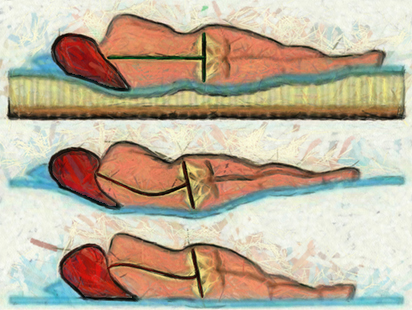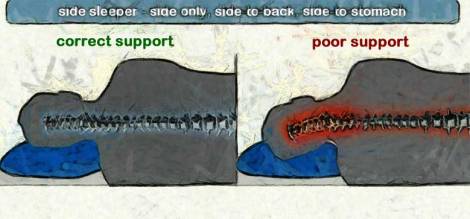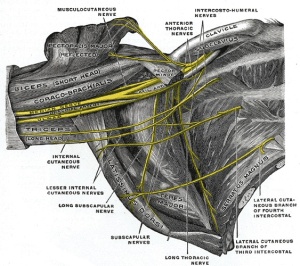Side sleeping is very common, especially with pregnant moms-to-be, and couples sharing a bed. Pregnant women don’t really have a choice, as back sleeping usually isn’t comfortable as the weight of the baby can put pressure on the kidneys and other organs.
A number of things are going on when the body stays propped up on its side for 6-8 hours at a time. Side sleeping puts the body in the least stable position, on its smallest edge. The arm that is underneath the body often gets compressed for many hours at a time. Oftentimes, the compression of the arm is what causes restless tossing and turning during the night. Hip and neck position can create curvature of the body which causes misalignment of the spine. For side sleeping, pillow should be placed to keep the head and neck straight, and a softer mattress should be used to allow the hip to sink in to prevent the misalignment of the sacral iliac joint of the pelvis. A softer mattress such as memory foam is also important for side sleeping, as many issues can arise from discomfort where the majority of the body weight is transferred to a firm mattress through only a few pressure points. The higher the amount of contact your body has with a softer mattress that conforms to the curvature of the body, the more the weight is distributed and less problems will arise.
The signs that I notice of a client who sleeps on their side are: neck & shoulder tension, jaw clenching, tightness in the chest (which can also cause difficulty breathing), kyphosis, pain/numbness/tingling down the arm (the tighter arm is usually the side the client sleeps on most often), tension/pain between the shoulder blades, and lower back/hip tightness/pain.
The side of the face that is pressed up against the pillow can often develop tightness of the jaw, which leads to grinding or clenching of the teeth, and in the worst cases, TMJ disorder. One way to stop from grinding your teeth is to wear a mouth guard during sleep. However, you can teach your body to stop clenching or grinding during sleep. It takes daily stretching and ensuring that the position of the jaw is slightly open when laying down and ensuring that the pillow doesn’t focus pressure along the jaw line, especially the masseter muscle. If you are still having trouble teaching your body to do this, one way I made sure my jaw stayed slack while sleeping was to place enough of my tongue between my teeth that I would wake myself up if I started clenching. As far as I can remember, I never woke myself up from it, let alone bit the tip of my tongue off.
One way to supplement teaching your body to stop clenching or grinding your teeth is to do TMJ self-care exercises.
Neck and shoulder tension often occurs when the pillow is too large and elevates the head above the spine, or is too small and the head droops below the level of the spine. The tension and pain generally occurs on the side that has the shoulder elevated which has the levator scapula and upper trapezius muscles contracted. The worst case is usually when the pillow is too low to sufficiently support the head which combines the contracted and elevated shoulder with the compression of the arm and chest on the side of the body that is facing down.
Side sleeping puts an awkward amount of pressure and compresses the arm and chest of the side of the body that is on the bottom. One way to reduce the pressure on the arm is to put a soft cradling pillow under the torso to lift your body off the bed. The pillow should start just under the armpit and go down only to the pelvis. The extra space gives the arm some extra room and reduces direct pressure. The arm should be extended out in front of he body and another pillow should be added in front of the chest for the arms to wrap around to hug. This position gives your body some extra stabilizing support.
There is an old wives’ tale that you should never sleep on the left side of the body because it is bad for the heart. While modern medicine says that the blood flow from the heart is not affected by sleeping position, there are obvious connections between the heart and the left arm. One of the symptoms of a heart attack is numbness, tingling or pain down the left arm. This is described as a radiating nerve pain that affects the shoulder or arm. The thing about nerves is that they are bidirectional. So if a source of a problem, such as a heart attack, can affect the nerve down the arm, then compression of the nerve down the arm should theoretically be able to affect the heart on the other side, should it not?
There are three common paths of nerve impingement: median nerve impingement, which is indicated by numbness in the thumb, index, and middle finger; ulnar nerve impingement, which affects the ring finger, pinky finger, and/or back of the elbow; or worst of all, brachial nerve impingement, which is indicated by numbness and tingling of the whole hand or arm. Brachial nerve impingement is usually caused by compression higher up on the nerve, which affects both the radial and ulnar branches of the nerve.
In most cases, median nerve impingement can be cause by tightness in the anterior deltoid, biceps brachii, brachialis, brachioradialis, and the flexor carpi digitorum muscles. It’s important to check all of these places because when you release the tension of one of these muscles, the nerve sensation can change. When the pressure on the nerve is released in one spot, there still may be compression of the nerve that simply wasn’t getting the signal until the compression higher up on the arm allowed the signal down lower on the arm. Generally speaking, it is better to release the tension higher up on the arm first and work your way down so the client can notice the change of sensation gradually. Also, often times nerve impingement goes hand in hand with reduced blood flow. Releasing the tension in the proximal part of the body first, will allow the blood to flow further down the arm.
For ulnar nerve impingement, the centers of tension can be the infraspinatus, supraspinatus, subscapularis, serratus magnus, latissimus dorsi, teres major, triceps, flexor carpi ulnaris, and the hypothenar muscles.
Often times, nerve impingement can occur higher up, which will affect the entire arm. This happens most commonly in the neck, where the brachial plexus passes under the anterior scalenes; and in the chest, where the brachial plexus passes underneath the clavicle bone, the subclavius, and the pectoralis minor muscles.




